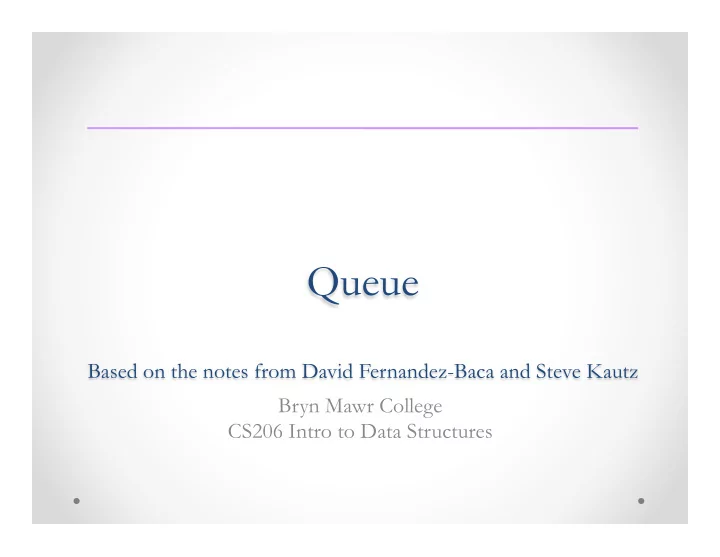

Queue Based on the notes from David Fernandez-Baca and Steve Kautz Bryn Mawr College CS206 Intro to Data Structures
Queue • A queue is a list that operates under the first-in first-out ( FIFO ) policy: o read or remove only the item at the front ( head ) of the queue o add an item only to the back ( tail ) of the queue o examine the front item. • java.util contains a Queue<E> interface that contains all the methods you would expect from a FIFO queues, as well as other kinds of queues. Java offers several implementations, for example the LinkedList class.
The Java Queue Interface • E element(). Retrieves, but does not remove, the head of this queue. Throws NoSuchElementException if this queue is empty. • E peek () . Retrieves, but does not remove, the head of this queue, or returns null if this queue is empty. • boolean add (E e). Inserts the specified element into this queue if it is possible to do so immediately without violating capacity restrictions, returning true upon success and throwing an IllegalStateException if no space is currently available
The Java Queue Interface (cont.) • boolean offer (E e). Inserts the specified element into this queue if it is possible to do so immediately without violating capacity restrictions. • E poll (). Retrieves and removes the head of this queue, or returns null if this queue is empty. • E remove (). Retrieves and removes the head of this queue. Throws NoSuchElementException if this queue is empty. Since Queue<E> extends Collection<E>, it inherits all of the latter ʼ s methods, including isEmpty(), size(), and iterator().
Implementation – Linked List • A queue is easily implemented as a singly-linked list with a tail pointer. • It is perhaps even better to use a circular list. In this case, a pointer to the last node also gives easy access to the first node, by following one link. Thus we can handle the structure by a single pointer, instead of two.
Implementation – Array-Based We use an array a to store the elements. Additionally, we have two indices: o first: points to first element of queue (front) o last: points to first available slot in the array (just before the back) We initialize first = last = 0. The queue is empty when first == last. • To enqueue, put the new item in A[last] and increment last. • To dequeue, return A[first] and increment first.
Implementation – Circular Array • A potential problem using array: After a series of enqueue/dequeue operations, both first and last are at the end of the array even though the array is not full. • Solution: treat the array as being circular. That is, when last == A.length and we need to increment last to insert a new item, we just reset last to 0. last = (last + 1) % A.length; Note that we still use the convention that the queue is empty when first == last. This means that at least one entry of array A will always have to be left unused. Otherwise, we wouldn ʼ t be able to distinguish between an empty queue and a full one.
Recommend
More recommend